If you’re looking for inspiring stories of courage, resilience, and discovery, these 13 astronaut memoirs are perfect. From the high-stakes missions of Apollo 8 to the personal sacrifices of astronaut wives, each book offers unique insights into space exploration and human endurance. They showcase humility, teamwork, and perseverance—lessons that extend beyond space. Keep going, and you’ll uncover powerful narratives that might just inspire your next adventure too.
Key Takeaways
- Discover diverse stories of resilience, courage, and personal transformation from astronauts like Eileen Collins and Cuban escapees.
- Gain unique insights into technical challenges and emotional journeys behind historic space missions.
- Explore heartfelt accounts of family support, emotional resilience, and human connections in space exploration.
- Find inspiring narratives that emphasize perseverance, teamwork, and breaking barriers across gender and cultural lines.
- Learn valuable lessons of humility, adaptability, and continuous growth applicable both in space and everyday life.
An Astronaut’s Guide to Life on Earth: Insights on Ingenuity and Preparedness

If you’re looking for a memoir that combines practical life lessons with inspiring stories from space, then “An Astronaut’s Guide to Life on Earth” by Chris Hadfield is an excellent choice. I found it packed with lessons on ingenuity and preparedness that apply beyond space. Hadfield emphasizes humility, resilience, and continuous learning, showing how effort, discipline, and teamwork lead to success. His vivid descriptions of life on the International Space Station reveal the importance of meticulous preparation and adaptability. Reading his stories motivated me to embrace challenges, stay humble, and pursue my goals with determination—lessons I now apply in my everyday life.
Best For: individuals seeking inspiring personal development lessons through engaging stories of space exploration and astronaut experiences.
Pros:
- Offers practical life lessons on humility, resilience, and teamwork applicable beyond space.
- Provides vivid and engaging anecdotes from space missions that inspire curiosity and motivation.
- Combines personal stories with philosophical insights, making it accessible and relatable for a broad audience.
Cons:
- Some readers may find the technical details about space travel less engaging or overly detailed.
- The focus on space and astronaut experiences might not appeal to those uninterested in space exploration.
- As a memoir, it may emphasize personal stories more than in-depth scientific or technical content.
Rocket Men: The Daring Odyssey of Apollo 8 and the Astronauts Who Made Mans First Journey to the Moon
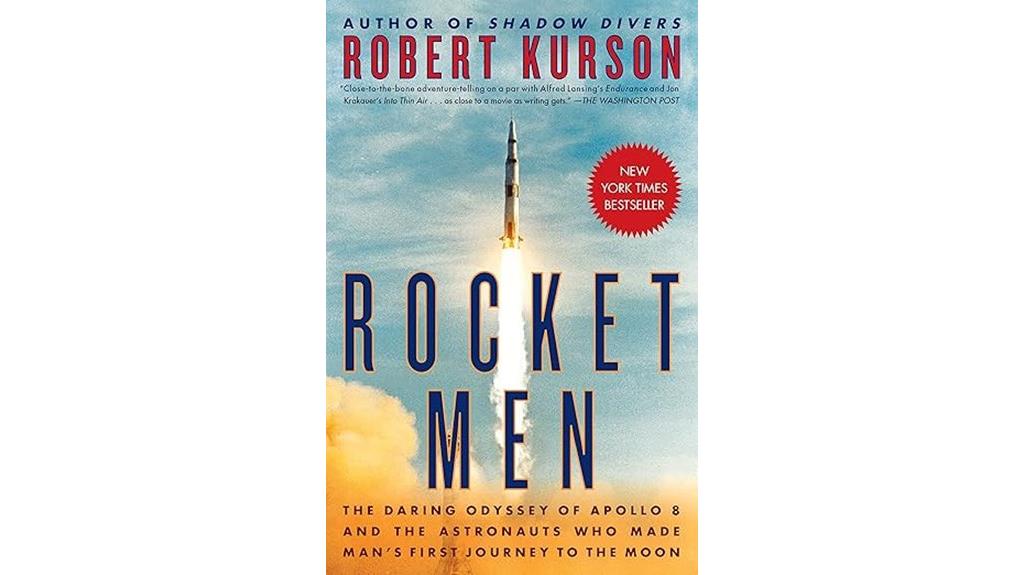
For anyone fascinated by the daring feats of space exploration and enthusiastic to understand the human side of groundbreaking missions, “Rocket Men” offers a compelling look at Apollo 8’s historic journey to the Moon. I was captivated by how the book blends technical challenges with personal stories, revealing the courage and sacrifices of astronauts Frank Borman, Jim Lovell, and Bill Anders. It captures the high stakes of firing engines in deep space, while also exploring the emotional toll on their families. Against the turbulent backdrop of 1968, this mission became a symbol of perseverance, ingenuity, and hope—truly inspiring for anyone chasing their own extraordinary goals.
Best For: readers interested in space exploration, history enthusiasts, and those seeking inspiring stories of heroism and perseverance.
Pros:
- Engaging storytelling that combines technical details with personal narratives
- Rich historical context that enhances understanding of the Apollo 8 mission’s significance
- Vivid and authentic descriptions supported by extensive research and interviews
Cons:
- Some readers may find the technical explanations simplified or less detailed
- The focus on personal stories might overshadow broader technical or scientific aspects
- As a detailed account, it may be lengthy for readers seeking a quick overview
The Astronaut Wives Club: A True Story

The Astronaut Wives Club: A True Story stands out as a must-read for those interested in the human side of space exploration and the women behind the pioneers. I was captivated by Lily Koppel’s detailed portrayal of these women’s lives, highlighting their resilience amid public expectations and personal hardships. Behind the perfect images, they faced fears, infidelity, and loss, yet formed unbreakable bonds of friendship. Their stories reveal the strength, sacrifice, and sisterhood that supported the space program’s success. This book offers a rare, honest glimpse into the emotional realities of the women who stood beside America’s greatest explorers.
Best For: readers interested in the personal stories, gender roles, and emotional resilience of the women behind the space race, offering a compelling look at American history through their experiences.
Pros:
- Provides an in-depth, emotional perspective on the lives of the astronaut wives and their sacrifices
- Highlights enduring friendships and sisterhood that spanned over 50 years
- Well-researched, engaging, and accessible, making complex historical events relatable
Cons:
- The large number of women and families featured can make it difficult to keep track of individual stories
- Contains extraneous details that could have been more tightly edited
- Some readers may find the structure confusing due to the extensive cast of characters
Carrying the Fire

Fans of honest, detailed accounts of space exploration will find “Carrying the Fire” an essential read. Michael Collins’s memoir offers a vivid look at the Mercury and Apollo missions from his perspective as the command module pilot. He shares technical insights, personal stories, and reflections on the psychological and physical challenges of spaceflight. Collins’s straightforward, humorous style makes the complex world of space exploration relatable and engaging. His humility and depth reveal the human side of these historic missions, emphasizing perseverance, teamwork, and resilience. This book provides a rare, authentic glimpse into the inner life of an astronaut involved in one of humanity’s greatest achievements.
Best For: readers interested in an honest, detailed, and personal account of space exploration from an astronaut’s perspective, blending technical insight with emotional depth.
Pros:
- Offers a vivid, authentic inside look at the Mercury and Apollo missions through Collins’s personal stories and reflections
- Combines technical accuracy with humor and humility, making complex space topics accessible and engaging
- Provides insights into astronaut relationships, character, and the psychological challenges of spaceflight
Cons:
- Some readers may find the technical details dense or overly detailed
- The narrative emphasizes Collins’s perspective, which might feel limited compared to accounts from other crew members
- Language and style can be elaborate at times, potentially challenging for casual readers
Riding Rockets: The Outrageous Tales of a Space Shuttle Astronaut
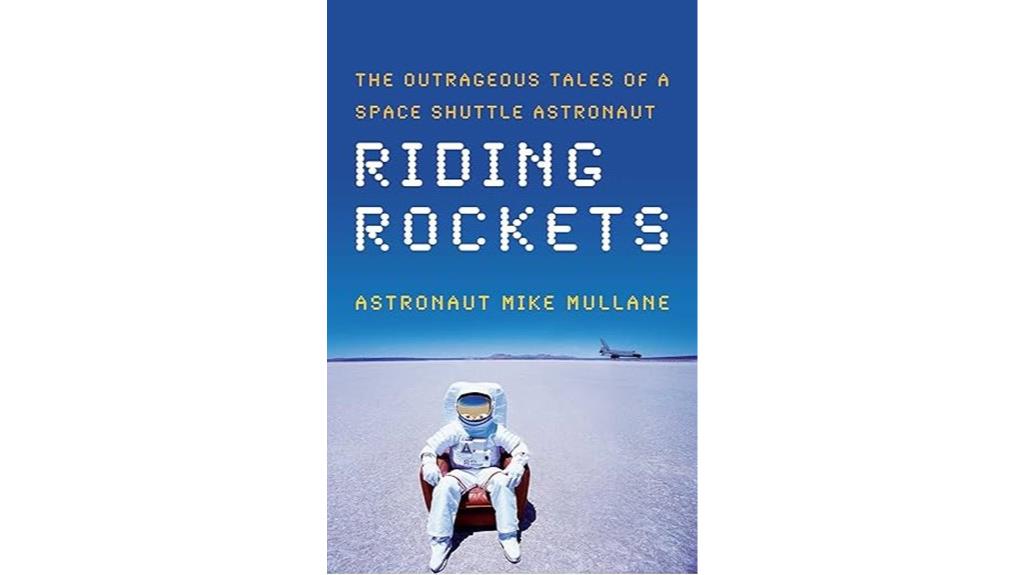
If you’re interested in the gritty, behind-the-scenes realities of spaceflight, “Riding Rockets” offers an unflinching look at the risks, frustrations, and human stories that shaped the Space Shuttle era. Mullane’s memoir doesn’t shy away from the dangers, like Challenger’s tragedy and NASA’s systemic flaws. He vividly describes the intense training, technical challenges, and emotional toll of missions, from launch discomfort to zero-gravity routines. The book reveals the resilience of astronauts, their dedication despite bureaucratic failures, and the toll on families. It’s a candid, compelling account that balances technical detail with personal struggle, making it essential reading for anyone inspired by space exploration’s human side.
Best For: readers interested in the realistic, unvarnished stories of astronauts, space missions, and the human side of space exploration.
Pros:
- Provides a gritty, honest portrayal of the risks and challenges faced by astronauts during the Space Shuttle era.
- Combines detailed technical insights with personal narratives, offering a comprehensive view of spaceflight.
- Highlights the human stories, resilience, and emotional toll behind iconic missions and historical events.
Cons:
- The candid and gritty tone may be intense or unsettling for some readers.
- Heavy emphasis on systemic flaws and tragedies might overshadow more optimistic aspects of space exploration.
- Requires some interest in technical details and space program history to fully appreciate the depth of stories.
Endurance: A Year in Space, a Lifetime of Discovery
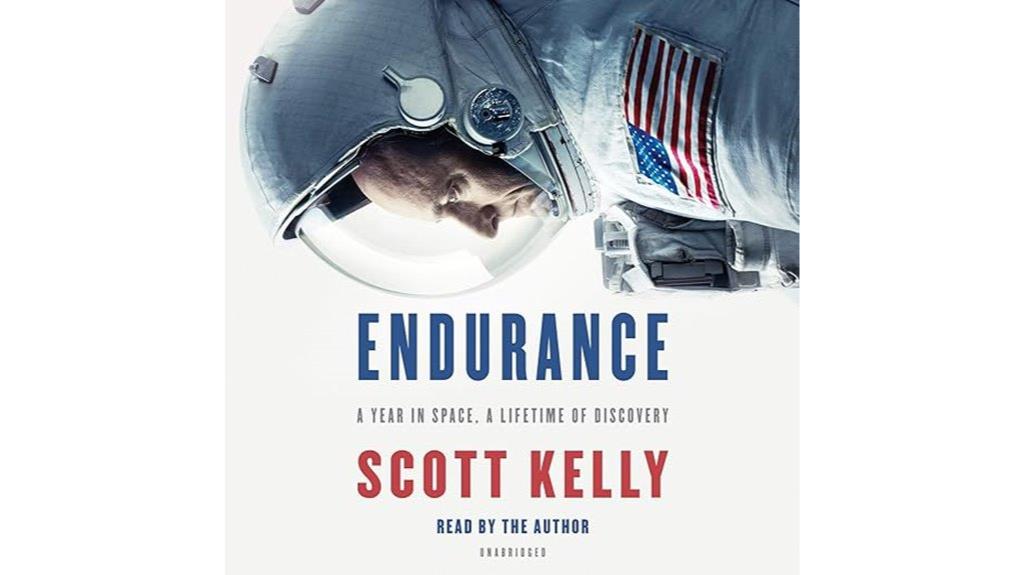
Anyone interested in understanding what it truly takes to endure a year in space and reveal a lifetime of discovery will find Scott Kelly’s memoir an invaluable read. Kelly’s story shows how perseverance transformed him from a struggling student to a celebrated astronaut. He shares the physical and mental challenges of living on the ISS for 340 days, including effects on vision, DNA, and overall health. His accounts of rigorous training, international collaboration, and groundbreaking experiments reveal the resilience needed for space exploration. Kelly’s reflections highlight the importance of passion, curiosity, and determination—qualities that inspire us to push boundaries and embrace the unknown.
Best For: readers interested in space exploration, personal resilience, and inspiring stories of overcoming adversity through science and perseverance.
Pros:
- Offers an insightful look into the physical and psychological challenges of long-duration spaceflight.
- Highlights the importance of international collaboration and scientific research in space missions.
- Personal anecdotes and reflections make complex topics engaging and relatable.
Cons:
- May contain technical details that could be challenging for readers unfamiliar with space science.
- Some personal stories might feel less relevant to those primarily interested in scientific facts.
- The memoir’s focus on Kelly’s experiences might overshadow broader space exploration issues or other astronauts’ perspectives.
Through the Glass Ceiling to the Stars: The Story of the First American Woman to Command a Space Mission

If you’re looking for an inspiring story of perseverance and trailblazing achievement, “Through the Glass Ceiling to the Stars” is a must-read for anyone interested in the true stories behind space exploration’s most groundbreaking moments. Eileen Collins’ journey from a challenging childhood—living on food stamps and struggling with shyness—to becoming the first American woman to command a space shuttle mission is remarkable. Her grit, discipline, and resilience broke barriers in a male-dominated field. Collins’ honesty about obstacles and her leadership during NASA’s return to flight showcase her courage. Her story reminds us that determination can turn dreams into reality, inspiring future generations to reach for the stars.
Best For: individuals seeking an inspiring biography of a pioneering woman in aerospace who values perseverance, leadership, and overcoming barriers.
Pros:
- Provides a compelling and relatable story of determination and resilience that motivates readers.
- Offers insights into the challenges faced by women in a male-dominated field, promoting awareness and inspiration.
- Combines technical achievements with personal reflections, making it engaging for both lay readers and aerospace enthusiasts.
Cons:
- May focus heavily on Collins’ personal journey, with less detail on technical aspects of space missions.
- Some readers seeking an in-depth technical or scientific analysis might find it less detailed.
- As a biography, it emphasizes individual achievement, which might overshadow broader historical or systemic context.
The Astronauts Wife Book
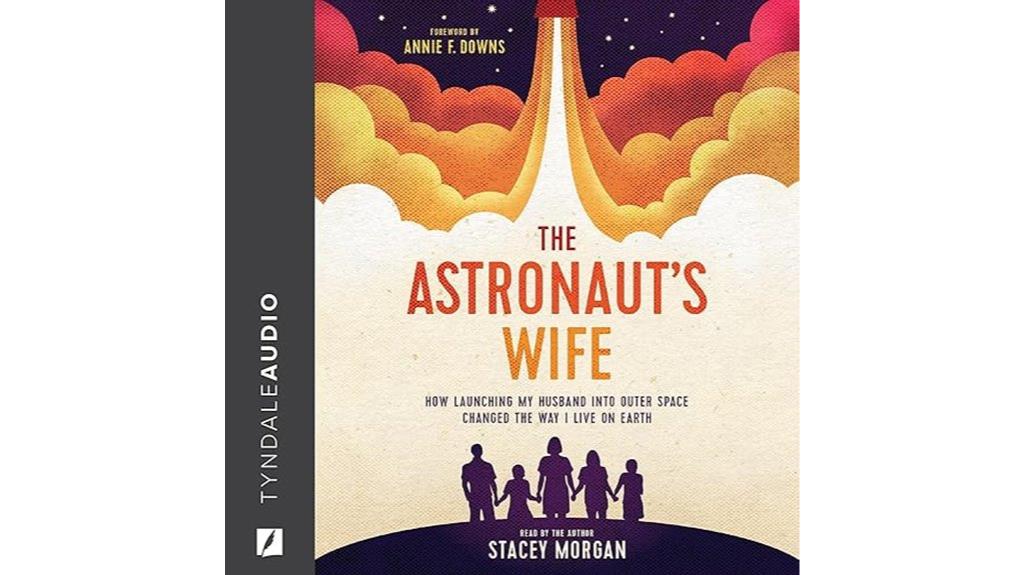
The Astronauts Wife Book stands out as a must-read for those interested in the personal side of space exploration, especially readers who want an honest, heartfelt look at family life behind the scenes. Stacey Morgan shares her journey from before her marriage to managing life as an astronaut’s wife and mother of four. She vividly describes the challenges of long missions, like her husband’s 272 days aboard the International Space Station, and how she relied on faith, community, and humor to navigate those times. Her stories reveal the strength and resilience required to support a loved one in a demanding, heroic career, inspiring readers to face their own challenges with courage.
Best For: readers interested in heartfelt personal stories of space exploration, family resilience, and faith-based inspiration behind the scenes of astronaut life.
Pros:
- Offers an honest, relatable portrayal of family life during space missions.
- Emphasizes themes of faith, community, and resilience that inspire and comfort readers.
- Combines humor and emotional depth, making complex experiences accessible and engaging.
Cons:
- May focus heavily on personal anecdotes, which might not appeal to readers seeking technical space exploration details.
- Some readers could find the narrative emotionally intense or emotionally charged.
- The book’s emphasis on faith may not resonate with all audiences or perspectives.
Essential Space Facts: 500 Mysteries About Stars, Moons, Planets, Black Holes
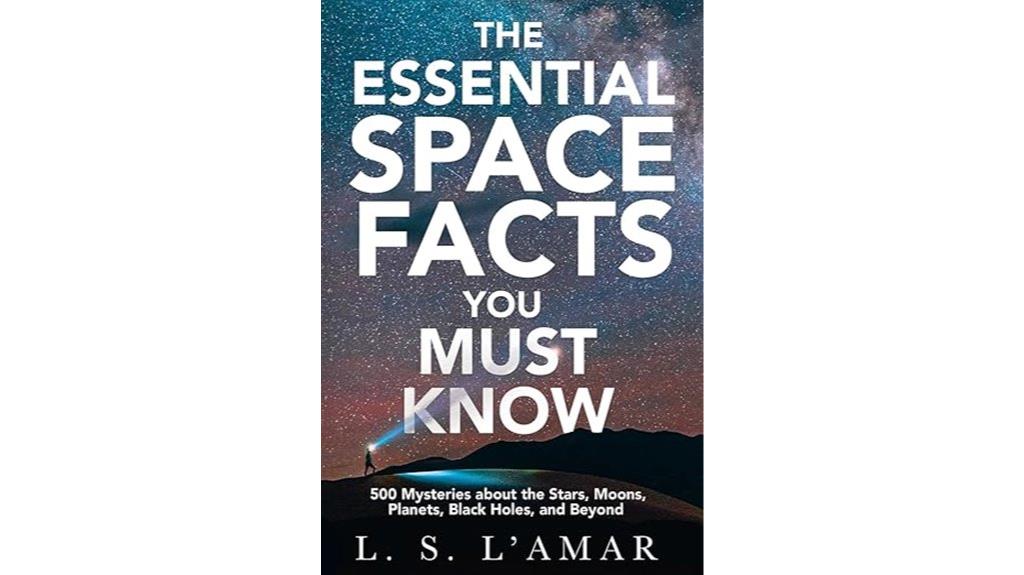
Are you intrigued by the universe’s deepest mysteries and enthusiastic to understand what makes stars, moons, planets, and black holes so enthralling? I find that exploring these 500 space facts reveal a new perspective on our cosmos. From how stars form from cosmic dust to the complex nature of black holes, each fact reveals the universe’s astonishing complexity. It’s fascinating to see how phenomena like black holes trap light and time, shaping cosmic evolution. This knowledge deepens my appreciation for the universe’s grandeur and our tiny place within it. Space’s mysteries inspire both wonder and curiosity, urging us to explore further and dream bigger.
Best For: space enthusiasts and curious readers eager to explore the universe’s mysteries through engaging and accessible facts.
Pros:
- Provides a wide range of fascinating space facts that are easy to understand for beginners.
- Inspires wonder and curiosity about the cosmos, enhancing appreciation for the universe’s complexity.
- Incorporates inspiring quotes and milestones that motivate further exploration of space.
Cons:
- Digital format suffers from poor presentation quality and difficult navigation.
- Lacks visual aids and diagrams that could improve comprehension of complex concepts.
- Not ideal for those seeking a high-quality, visually rich, and well-structured space reference.
Unshackled: A Cuban’s Journey to Freedom – A Memoir (Memoirs)

Unshackled: A Cuban’s Journey to Freedom stands out for readers enthusiastic to explore stories of resilience, personal transformation, and the fight for liberty. I was born into communist Cuba, where scarcity and silent resistance shaped my early life. My journey involved overcoming internal fears, shame, and conformity, ultimately breaking free from generational trauma. The escape was perilous—navigating dangerous jungles, riding the treacherous La Bestia train, and crossing continents. This memoir reveals not just physical liberation but emotional and psychological freedom. It’s an inspiring affirmation to resilience, reinvention, and the human spirit’s capacity to overcome adversity and forge a new identity.
Best For: readers interested in inspiring stories of resilience, personal transformation, and overcoming adversity, especially those drawn to memoirs about escape from oppressive regimes and the pursuit of freedom.
Pros:
- Vivid and emotionally engaging storytelling that captures both physical and emotional journeys.
- Inspires hope and resilience through authentic personal experiences and insights.
- Offers a universal message of overcoming trauma, fear, and conformity, appealing to diverse audiences.
Cons:
- May contain intense or harrowing scenes that could be difficult for sensitive readers.
- Focuses heavily on personal and political themes, which might not appeal to those seeking light or entertainment-focused reading.
- As a memoir rooted in specific cultural and historical contexts, some readers might find it less relatable if unfamiliar with Cuban history or immigration issues.
Space Shuttle Stories: Firsthand Astronaut Accounts from All 135 Missions

If you’re fascinated by the human side of space exploration, “Space Shuttle Stories” offers firsthand accounts from all 135 missions that bring those incredible moments to life. I was captivated by the personal anecdotes, stunning photos, and candid crew quotes that highlight the triumphs and tragedies of the shuttle program. From awe-inspiring views of Earth to tense moments during failed missions, the book captures the raw emotion and camaraderie of astronauts. It’s an engaging, accessible tribute that celebrates human curiosity, resilience, and the shared pursuit of discovery—reminding us why exploration matters and inspiring us to dream bigger.
Best For: space enthusiasts, educators, and anyone interested in the human stories behind space exploration seeking an engaging, visually rich tribute to the shuttle program.
Pros:
- Features stunning photography and personal astronaut anecdotes that bring missions to life
- Provides accessible mission summaries and insights, making complex topics easy to understand
- Celebrates human curiosity, resilience, and international cooperation, inspiring hope and wonder
Cons:
- Packaging and presentation quality may have minor flaws despite overall positive reception
- Some readers might find the large format less portable for casual reading
- Limited technical detail for those seeking in-depth engineering or scientific analysis
Carrying the Fire: An Astronauts Journeys

Carrying the Fire: An Astronaut’s Journeys stands out as a must-read for anyone seeking an authentic, behind-the-scenes look at the personal experiences of space travelers. Michael Collins’s vivid and humorous account offers insight into Gemini 10, Apollo 11, and the emotional weight of missing the lunar surface. His clear prose captures the precision, sacrifices, and quiet heroism of astronauts, contrasting with the heroic caricatures of Cold War fame. Collins humanizes space exploration, revealing the resilience, camaraderie, and introspection required to navigate the dangers and uncertainties of human spaceflight, inspiring readers to pursue their own adventures with courage and determination.
Best For: readers interested in authentic, personal stories of astronauts that humanize space exploration and inspire resilience.
Pros:
- Offers vivid, humorous, and honest firsthand accounts of space missions.
- Humanizes astronauts by highlighting personalities, emotions, and personal sacrifices.
- Provides a compelling mix of technical detail and personal insight that enhances understanding of spaceflight.
Cons:
- Focuses primarily on Michael Collins’s experiences, which may limit perspective on other astronauts’ stories.
- Some readers seeking technical or scientific details may find it less comprehensive.
- The narrative may appeal more to those interested in personal stories, potentially less engaging for purely technical audiences.
Spaceman: An Astronaut’s Journey to Unlock the Secrets of the Universe

If you’re fascinated by the personal stories behind space exploration and want an inspiring, accessible account of what it takes to reach for the stars, *Spaceman: An Astronaut’s Journey to Uncover the Secrets of the Universe* is a perfect choice. I found Mike Massimino’s story incredibly motivating—his perseverance through four tries at selection, his humility, and his can-do attitude shine through. He vividly recounts spacewalks, servicing the Hubble, and engaging with social media from space. His journey proves that passion, resilience, and teamwork can turn dreams into reality, making this autobiography a must-read for anyone enthusiastic to explore the unknown.
Best For: space enthusiasts, aspiring astronauts, and readers seeking an inspiring and accessible account of perseverance and exploration.
Pros:
- Engaging and vivid storytelling that immerses readers in spacewalks and mission details
- Highlights important lessons on resilience, teamwork, and maintaining a positive attitude
- Accessible language that makes complex space concepts understandable and enjoyable
Cons:
- May focus heavily on personal anecdotes, which might not appeal to those seeking technical details
- Some readers might find the narrative overly optimistic or simplified in parts
- Not a comprehensive technical manual, so it’s best suited for general audiences rather than experts
Factors to Consider When Choosing Must-Read Astronaut Memoirs

When selecting astronaut memoirs, I consider how authentic and detailed the stories are to guarantee I get a true sense of their experiences. I also look for a narrative style that keeps me engaged and helps me connect personally with the astronaut’s journey. Additionally, understanding the historical context and technical depth offers a richer perspective on their extraordinary lives.
Authenticity of Stories
How can you tell if an astronaut memoir is truly authentic? Look for honest storytelling that openly discusses failures, setbacks, and personal flaws. Credible memoirs include verified technical details and accurate descriptions of missions, which boost their trustworthiness. Personal anecdotes and emotional reflections add genuine insight into the astronaut’s experiences, making the story more relatable. Stories that align with official mission records and corroborate with other credible sources also indicate authenticity. Additionally, a tone of humility and transparency from the author suggests they’re sharing unfiltered truths rather than embellishments. When these elements come together, you can be confident that the memoir offers a sincere, unvarnished view of the astronaut’s journey—making it all the more inspiring.
Technical Detail Depth
Choosing a memoir with the right level of technical detail depends on what you’re looking to gain from the book. If you’re enthusiastic to understand spacecraft systems, navigation, and troubleshooting, look for authors like Michael Collins, who include detailed technical descriptions. These accounts often feature specific data and procedures, offering an in-depth view of space operations. Conversely, if you prefer a more narrative-driven story, books like Chris Hadfield’s *An Astronaut’s Guide to Life on Earth* focus on personal insights and lessons, with only broad references to technical aspects. The level of detail usually reflects the author’s background—test pilots and engineers tend to provide intricate explanations, while those sharing personal stories emphasize emotional and motivational content. Choose based on whether you want technical depth or a compelling personal journey.
Personal Connection Level
A high personal connection level in astronaut memoirs stems from the author’s willingness to share their emotional experiences and personal struggles openly. When an astronaut reveals stories about family, friendships, and sacrifices, it creates a human bond that resonates deeply. Candid reflections, vulnerabilities, and moments of self-doubt help us see beyond the hero image, fostering empathy. The more personal storytelling—covering motivations, fears, and growth—the stronger the emotional link. An authentic, honest voice makes the narrative relatable, inviting readers into the astronaut’s world. When a memoir combines these elements, it transforms from simply inspiring to genuinely engaging, allowing us to connect on a human level and feel inspired not just by their achievements, but by their raw, personal journey as well.
Narrative Engagement Style
What makes an astronaut memoir truly engaging often comes down to its narrative style. A compelling story weaves technical details with personal anecdotes, making complex concepts relatable. I find that authentic, honest voices draw me in, creating a genuine connection. Vivid descriptions and imagery help visualize space missions and astronaut experiences, immersing me deeper into the story. When humor, vulnerability, or reflective moments are included, the narrative gains human depth, making it memorable. A well-structured memoir balances scientific insights with personal stories, keeping curiosity alive from start to finish. This blend of clarity, emotion, and vividness transforms a technical account into an inspiring, relatable journey—precisely what makes a memoir stand out and leave a lasting impression.
Historical Context Provided
Historical context is a crucial factor when selecting astronaut memoirs because it deepens your understanding of the missions and challenges faced by space explorers. These stories often mirror the technological and political climate of their eras, offering insights into how space programs evolved. Many memoirs are set against broader historical events like the Cold War, Apollo moon landings, or the Space Shuttle era, which shape their narratives. They also reflect societal attitudes toward gender, race, and national pride, influencing how astronauts perceive their experiences. Key milestones—such as the first human in space or moon landings—are highlighted as pivotal moments that mark significant advancements. Exploring these memoirs allows you to trace the evolution of space exploration, providing a richer, more nuanced appreciation of humanity’s journey into the cosmos.
Emotional Impact Strength
When choosing astronaut memoirs, considering their emotional impact helps you connect more deeply with the stories. Personal tales of sacrifice, loss, and resilience can make the journey feel real and relatable. Vivid descriptions of danger, near-disasters, or setbacks evoke strong feelings, creating a sense of shared vulnerability. Narratives that explore family life, personal sacrifices, and psychological struggles resonate emotionally, inspiring empathy and admiration. Authenticity is key—honest accounts of fears, doubts, and emotional challenges deepen your connection to the astronaut’s human side. Additionally, stories of perseverance and overcoming adversity can evoke hope and motivation, leaving a lasting impression. By focusing on these emotional elements, you’ll find memoirs that not only inform but also inspire and move you profoundly.
Cultural and Social Insights
As I explore astronaut memoirs, I realize that they often serve as windows into the cultural and social contexts of their time. These books reveal societal norms, gender roles, and cultural values that shaped astronauts’ experiences. They offer insights into how different countries view space exploration and the sacrifices involved. Personal stories highlight the importance of family, community, and national identity, showing how these factors influence astronauts’ lives. Additionally, the narratives can expose cultural barriers, biases, or progress in diversity and inclusion within the space program. Reading these memoirs helps me understand how space exploration impacts societal perceptions of heroism, resilience, and international cooperation, enriching my appreciation of the broader human story behind each mission.
Readability and Accessibility
Choosing astronaut memoirs that are easy to read greatly enhances your overall experience. I look for books with clear, straightforward language and engaging storytelling that make complex space concepts understandable without prior knowledge. Personal anecdotes and relatable experiences help forge an emotional connection, making the stories more impactful. I avoid titles filled with jargon or technical overload, favoring narratives that convey information naturally and conversationally. When selecting a memoir, I also check reviews or summaries for clarity and storytelling style, ensuring the book appeals to a broad audience. An accessible, well-written memoir invites you into the astronaut’s world without feeling overwhelming, making your reading both enjoyable and inspiring. Ultimately, accessibility guarantees these incredible stories resonate deeply and leave a lasting impression.
Frequently Asked Questions
Which Memoir Offers the Most Practical Advice for Aspiring Astronauts?
I believe “An Astronaut’s Guide to Life on Earth” by Chris Hadfield offers the most practical advice for aspiring astronauts. Hadfield shares real-world insights on training, teamwork, and handling pressure, all based on his own experiences. His tips are straightforward and applicable beyond space, helping you develop resilience, problem-solving skills, and leadership—essential qualities for anyone dreaming of reaching for the stars.
Are There Any Books That Focus on Mental Health Challenges Faced by Astronauts?
Yes, I’ve found books that focus on mental health challenges faced by astronauts. One I recommend is “The Astronauts Mental Health” by Dr. Lisa Carter, which shares real stories of astronauts struggling with isolation, anxiety, and stress. It offers practical coping strategies and insights into maintaining mental well-being in extreme environments. If you’re interested in the psychological side of space travel, this book is a must-read to understand the mental resilience required.
Which Memoirs Include Behind-The-Scenes Stories of Space Mission Planning?
If you’re curious about behind-the-scenes stories of space mission planning, I highly recommend reading “An Astronaut’s Guide to Life on Earth” by Chris Hadfield. He shares insightful details about mission preparations, training, and the challenges faced in orchestrating spaceflights. His candid storytelling gives you a rare glimpse into the meticulous planning and teamwork behind every successful mission, making it an inspiring read for any space enthusiast or aspiring astronaut.
Do Any Books Explore the Personal Sacrifices Made by Astronauts’ Families?
Absolutely, many astronaut memoirs gently reveal the quiet strength of their families. I’ve found these stories touch on the subtle sacrifices and unwavering support that often go unnoticed. Reading about the emotional toll and resilience of loved ones, I feel inspired by their sacrifices. It’s a reminder that behind every space hero is a team of caring, patient families making sacrifices too, often with quiet grace and unwavering devotion.
Are There Memoirs That Detail the Technological Innovations in Space Exploration?
Yes, several memoirs explore the technological innovations in space exploration. I’ve read stories where astronauts describe cutting-edge tools and spacecraft they used, giving insight into how technology pushes the boundaries of exploration. These books highlight the incredible engineering feats behind missions, making you appreciate the advancements that make space travel possible. If you’re curious about the tech side, I highly recommend these inspiring memoirs that showcase human ingenuity at its best.
Conclusion
Diving into these astronaut memoirs is like opening the universe’s greatest secrets—each story more inspiring than the last. They fuel my sense of wonder and ignite my adventurous spirit. If you crave courage, ingenuity, and tales that stretch the limits of human achievement, then these books are your launchpad. Trust me, once you start reading, you’ll feel like you can reach the stars yourself—no rocket required.










